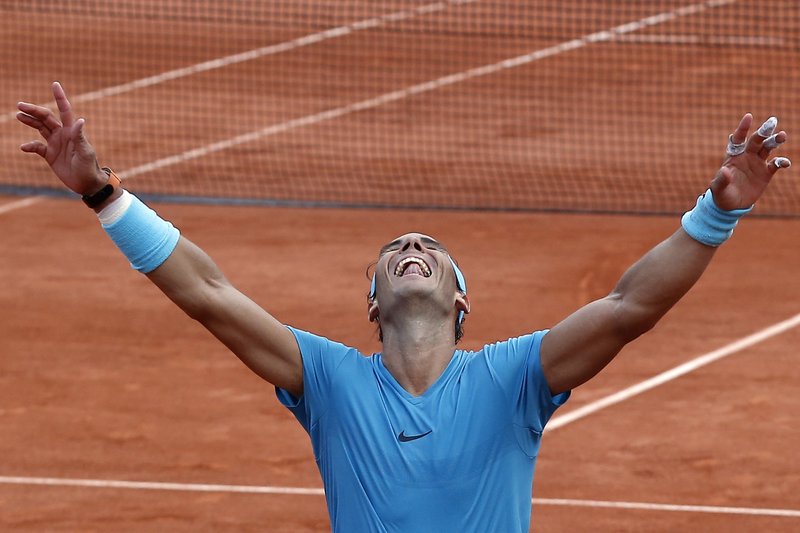
Spain’s Rafael Nadal celebrates winning the men’s final match of the French Open tennis tournament against Austria’s Dominic Thiem in three sets 6-4, 6-3, 6-2, at the Roland Garros stadium in Paris, France, Sunday, June 10, 2018. (AP Photo/Michel Euler)
PARIS — As Rafael Nadal and Dominic Thiem warmed up before the French Open final, the booming voice of an announcer at Court Philippe Chatrier called out each player’s bona fides.
Nadal’s introduction included a year-by-year accounting of every time he’d already won the title at Roland Garros. The crowd responded, initially offering polite applause, then adding their voices, rising into a full-throated roar.
Go ahead and 2018 to the lengthy list. Nadal won his record-extending 11th championship at the French Open on Sunday, overcoming a late problem with a finger on his racket-swinging hand and displaying his foe-rattling best for a 6-4, 6-3, 6-2 victory over No. 7 seed Thiem, the only person to beat the Spaniard on clay over the past two seasons.
Up a break at 2-1 in the third set, Nadal stopped serving after a fault because he couldn’t straighten his left middle finger. At the following changeover, Nadal was given a salt pill by a doctor and had his left forearm massaged by a trainer.
“Tough moment in the third set when I got a little bit cramped on the hand,” Nadal said. “I was very scared.”
Nadal’s form never wavered, though, and soon enough he was celebrating his 17th Grand Slam title overall, second among men only to Roger Federer’s 20. The two stars have combined to win the past six majors.
The victory also allowed the 32-year-old Nadal to hold onto the No. 1 ranking, just ahead of Federer.
Nadal called it “not even a dream” to gather 11 titles in Paris, saying it was “impossible to think of something like this.”
Thiem, a 24-year-old from Austria, was appearing in a major final for the first time. Not much more of a daunting task than doing so against this particular opponent at the French Open, where Nadal is now 11-0 in finals and 86-2 overall. The only losses came against Robin Soderling in the fourth round in 2009 and Novak Djokovic in the quarterfinals in 2015.
“What you did and what you are doing,” Thiem told Nadal during the trophy ceremony, “is one of the most outstanding things that any athlete is doing in any sport.”
If there were any reason for a bit of intrigue entering Sunday’s match, it was this: Thiem beat Nadal in two sets on red clay at Rome in May 2017 and again at Madrid last month.
“I am sure you will win here in the next couple of years,” Nadal told Thiem afterward.
Nadal is so dominant and so impervious on clay, in general, and at this tournament, especially, it made sense for Thiem to go for broke as much as possible, accepting that there would be risks along with the rewards. If standard play would likely lead to a loss, why not try for the spectacular, instead?
So that’s what Thiem tried. He pounded huge serves, topping 135 mph (220 kph) — about 25 mph (40 kph) more than Nadal’s fastest — and that translated into seven aces, but also five double-faults. He attempted drop shots; some worked, some didn’t. And he took the biggest of big cuts on his groundstrokes, his feet leaving the ground as he threw his whole body into them, as if the very outcome of the match — not any individual point, but the whole shebang — depended on the strength of that one whip of his white racket. That led to 34 winners (eight more than Nadal), but also 42 unforced errors (18 more than Nadal).
It worked. For a bit.
Thiem stayed with Nadal in the early going on a cloudy and steamy afternoon; the temperature was 77 degrees (24 Celsius), the humidity approached 70 percent. Midway through the opening set, Nadal’s aqua T-shirt was so soaked with sweat it stuck to him, so he changed into a fresh one at a changeover, drawing catcalls from spectators.
From 4-all, 15-all in the opening set, Thiem faltered. After Nadal held there for 5-4, Thiem basically handed over the next game — and the set — by making four mistakes in a row. A volley into the net. A forehand wide. A forehand into the net. A forehand long. Just like that, Nadal was off on a five-game run that put him up 3-0 in the second set.
Soon, Nadal was finding his spots. One down-the-line forehand winner landed right at the baseline and Thiem’s shoulders sagged as he muttered to himself. Another forehand winner from Nadal followed, and this time Thiem looked up toward his coach and yelled.
The conditions might have contributed to the cramping that affected Nadal about two hours into the final. His finger bent awkwardly and he pulled at it. He removed the taping from his left forearm, and maybe that let the blood flow better. After guzzling water during his visit from the doctor, Nadal was back to playing his unmistakable brand of nearly unbeatable clay-court tennis.